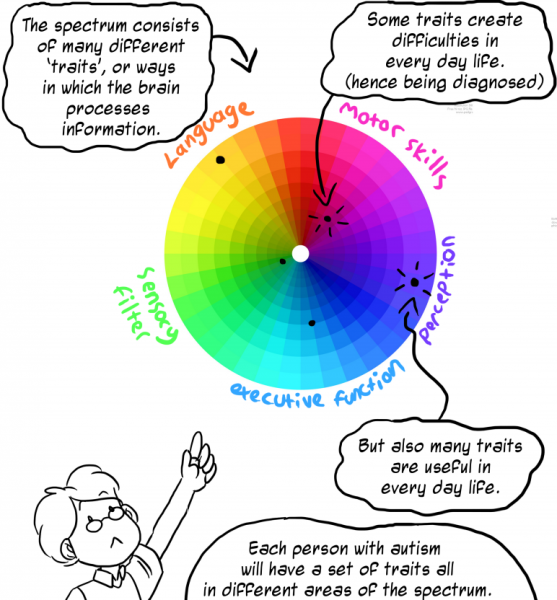An animated film providing an introduction to the autism spectrum. It was created as part of the UK Amazing Things Project. The video is available in a range of languages.
Source: Amazing Things
Key points about autism-takiwātanga
- autism-takiwātanga is a difference in development that affects communication (verbal and nonverbal), social skills and behaviour
- children with autism-takiwātanga can have a wide range of challenges and strengths, and these can vary with age and over time in an individual
- if your child does have autism-takiwātanga, there are services available to support your child, you and your whānau
Names for autism-takiwātanga
Takiwātanga means in his, her or my own time and space. It comes from a Māori phrase for autism - "tōku/tōna anō takiwā".
There is no single way of describing autism that everyone agrees on. People may refer to autism, autism spectrum, the spectrum and ASD. People with autism often prefer to identify as autistic, an autistic person, a person with autism or as an autistic individual. In the health system, it's often called autism spectrum disorder (ASD).
What is autism-takiwātanga?
Autism-takiwātanga is a difference in development that affects:
- communication (verbal and nonverbal)
- social skills
- behaviour
Communication and social skills
Communication and social skills develop in children at different rates. Communication involves many different skills. Children learn to understand what people say to them. They learn to speak clearly and use words and sentences to talk and to get their message across. They learn to understand and use gestures, signs and body language. They learn to look, listen and take turns in a conversation. Read more about how children learn to communicate.
Communication: What's Involved?
Children with autism-takiwātanga have differences in how they develop these skills. It may take them longer. The way they communicate and interact with others might always be different. For example, some children with autism-takiwātanga might take longer to learn to speak. Some may not speak at all. Others may learn to speak at the expected time.
"It is common for me and other people with autism to be unable to say the words to describe what is bothering us. It's also hard for us to figure out that other people don't experience the world the same way we do".
Behaviour
Children with autism-takiwātanga often have differences in the way they behave. They can sometimes enjoy a narrow range of interests which they like to repeat and they may also like to play with toys differently than other children. Children with autism-takiwātanga can sometimes make unusual movements with their body. They may have more difficulty with change than other children
The way that children with autism-takiwātanga experience their environment through their senses is different. They might find common sensations either calming and pleasant, or annoying and even painful. For example, they might find some loud sounds distressing. They might also find some body movements calming, such as rocking or spinning.
Autism-Takiwātanga Signs & Symptoms
Interpreting the world differently
Children with autism-takiwātanga interpret the world and what is happening around them differently than other children.
Autism-takiwātanga is different for every child who has it
When people talk about autism spectrum, they are referring to the wide range of differences in children with autism-takiwātanga. These differences can vary with age and can also vary over time in a child.
Rather than thinking about your child with autism-takiwātanga as sitting somewhere on a line, imagine each of their skills in a circle. Your child will have strengths in some areas and challenges in others.
This line isn't really helpful for thinking about your child with autism-takiwātanga

This circle may help you understand your child's mix of strengths and challenges. Each colour wedge in the circle represents a skill. Each black dot shows where in the circle a child sits for that skill. The skills in the circle are those where children with autism-takiwātanga can have differences.

See the full comic strip explanation.
Understanding The Autism Spectrum - A Comic Strip Explanation
How common is autism-takiwātanga?
Overseas figures vary from about 1 in 59 to 1 in 100. There is not much information about how common autism-takiwātanga is in Aotearoa New Zealand.
Autism-takiwātanga is more common in boys than girls. But this may be partly because not all girls with autism-takiwātanga have been diagnosed.
It might seem like there are more children with autism-takiwātanga now than in the past. This is probably because of better recognition than in the past. It could also be because of changes in autism-takiwātanga diagnosis.
Autism-takiwātanga occurs in children and adults - it is usually diagnosed in childhood. Sometimes a diagnosis is not made until the teenage years or adulthood when social demands exceed a person's abilities.
Causes of autism-takiwātanga
We don't know exactly what causes autism-takiwātanga but it is likely to be a combination of factors. Children with autism-takiwātanga are more likely to have a similarly affected family member. This suggests genetic factors play a part.
Some children will have a rare medical condition that may be associated with autism-takiwātanga.
Extensive research shows that the measles, mumps and rubella (MMR) vaccine does not cause autism.
More information
Check out all the KidsHealth content on autism-takiwātanga.
Acknowledgements
The quote from a person with autism - takiwātanga is reproduced from the New Zealand Autism Spectrum Disorder Guideline. (2nd edn).
Thank you to Rebecca Burgess for the images of the line and circle from her comic strip explanation of the autism spectrum. Rebecca is a freelance comic artist and illustrator living in the UK. See The art of autism - connecting through the arts.
References
Whaikaha - Ministry of Disabled People and Ministry of Education. 2022. Aotearoa New Zealand Autism Guideline: He Waka Huia Takiwātanga Rau: Third edition. Wellington: Whaikaha - Ministry of Disabled People.
